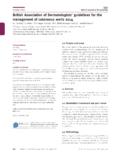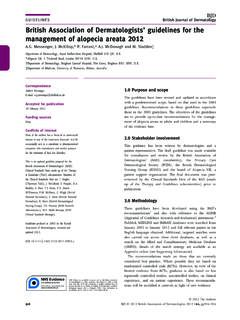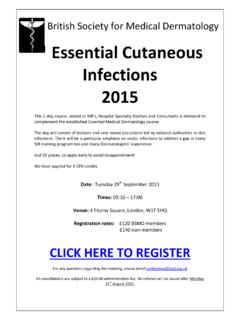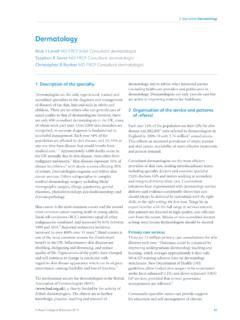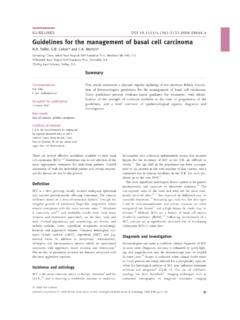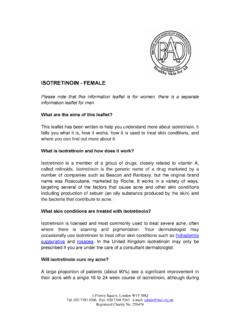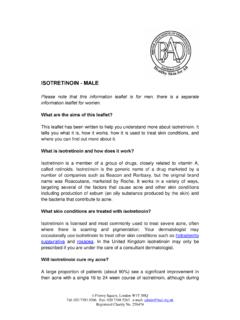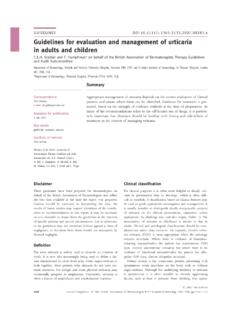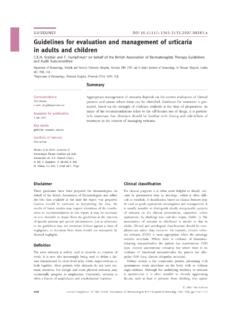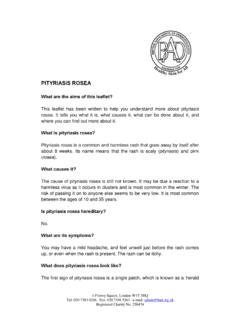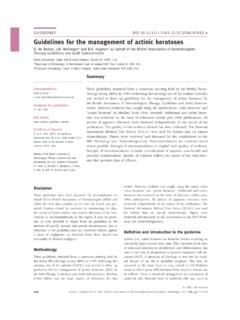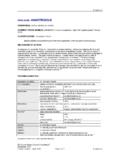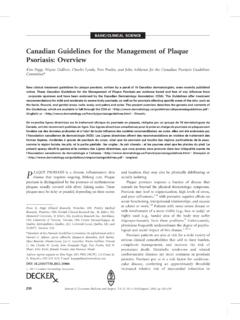Transcription of GUIDELINES Guidelines for the management of …
1 GUIDELINESG uidelines for the management of pemphigus , AND John s Institute of Dermatology, St Thomas Hospital, London, SE1 7EH for publication 15 May 2003 SummaryThese GUIDELINES for management of pemphigus vulgaris have been prepared for dermatologists onbehalf of the British Association of Dermatologists. They present evidence-based guidance fortreatment, with identification of the strength of evidence available at the time of preparation of theguidelines, and a brief overview of epidemiological aspects, diagnosis and words: GUIDELINES , immunosuppression, management , pemphigus vulgaris, therapy, treatmentDisclaimerThese GUIDELINES have been prepared for dermatologistson behalf of the British Association of Dermatologistsand reflect the best data available at the time the reportwas prepared.
2 Caution should be exercised in interpre-ting the data; the results of future studies may requirealteration of the conclusions or recommendations inthis report. It may be necessary or even desirable todepart from the GUIDELINES in the interests of patientsand special circumstances. Just as adherence to guide-lines may not constitute a defence against a claim ofnegligence, so deviation from them should not neces-sarily be deemed vulgaris (PV) is an acquired autoimmunedisease in which IgG antibodies target desmosomalproteins to produce intraepithelial, mucocutaneousblistering. Desmoglein (Dsg) 3 is the major antigenbut 50 60% of patients have additional antibodies toDsg1, the antigen in pemphigus foliaceus (PF).
3 1 3 Theunderlying antibody profile is a major determinant ofthe clinical phenotype of 5 The mortality of PV was 75% on average before theintroduction of corticosteroids (CS) in the early figure may be an underestimate due to lack ofdiagnostic criteria, inclusion of all subtypes of pemphi-gus and inclusion of other blistering disorders, such asbullous pemphigoid, which have a better , not all cases of PV have such a dismalprognosis. Studies differentiating according to clinicalphenotype have shown a lower mortality in patientswith predominantly mucosal PV (1 17%) comparedwith those with mucocutaneous PV (34 42%).7,8 Clinical presentationThe diagnosis of PV should be suspected in any patientwith mucocutaneous erosions or blisters.
4 The oralmucosa is the first site of involvement in the majority ofcases and PV may remain confined to the mucosalsurfaces or extend to involve the skin (average lagperiod 4 months). A minority will present with cuta-neous erosions but oral erosions occur in (almost) allcases. PV presents across a wide age range with peakfrequency in the third to sixth diagnosisA skin or mucosal biopsy should be taken for histologyand direct immunofluorescence (DIF), the latter requi-ring perilesional, intact skin or clinically uninvolvedCorrespondence: Dr of Dermatology, Leicester RoyalInfirmary, Leicester, LE1 5WW, : GUIDELINES were commissioned by the British Association ofDermatologists Therapy GUIDELINES and Audit subcommittee. Mem-bers of the committee are (Chairman), , , Thomas, , , Journal of Dermatology2003;149:926 2003 British Association of acantholysis and blister formation ishighly suggestive of PV but the diagnosis should beconfirmed by the characteristic deposition of IgG in theintercellular spaces of the epidermis.
5 Indirect immuno-fluorescence (IIF) is less sensitive than DIF10 12butmay be helpful if a biopsy is difficult, children anduncooperative adults. Enzyme-linked immunosorbentassays (ELISA) are now available for direct measure-ment of Dsg1 and Dsg3 antibodies in serum. They offeradvantages over IIF and may supersede this ,14 Five millilitres of blood is sufficient for IIFand patients with oral pemphigus, an intraoral biopsyis the optimum but IIF or DIF on a skin biopsy maysuffice. One study showed that the sensitivity of DIFwas 71% in oral biopsies compared with 61% innormal skin taken from 28 patients with oral study reported that the sensitivity of DIF was89% in oral biopsies compared with 85% for investigationsThe following investigations are suggested prior tocommencing treatment : biopsy (or IIF) as above, fullblood count and differential, urea and electrolytes, liverfunction tests, glucose, antinuclear antibody (differen-tial of pemphigus erythematosus), thiopurine methyl-transferase (TPMT) levels (if azathioprine is to be used),chest X-ray, urinalysis and blood pressure.
6 Currentguidelines on osteoporosis should be followed, so abone density scan early in the course of treatment maybe therapies in pemphigus vulgarisIn general, the quality of published data concerning thetherapy of PV is poor. There are few controlled trials,partly reflecting the rarity of PV. The majority of data isconfined to case reports and small case series with shortfollow-up periods in which PV cases of variable severityare included, often with other subtypes of are often used in combination, particularlyadjuvant drugs given concurrently with steroids, anddosing schedules vary widely. Controls are oftenindirect, involving comparisons of remission and mor-tality rates with historical controls or comparison ofmaintenance steroid doses before and after the additionof a given therapy.
7 Therefore, in most studies, it isdifficult to judge the effect of individual drugs and makefirm treatment recommendations. In these GUIDELINES ,we have listed the highest ranking level of evidence andgiven an overall recommendation for each therapy. Asummary of treatment options is given in Table principles of managementThe initial aim of treatment is to induce diseaseremission. This should be followed by a period ofmaintenance treatment using the minimum drug dosesrequired for disease control in order to minimize theirside-effects. Occasional blisters are acceptable andindicate that the patient is not being overtreated. Theultimate aim of management should be treatmentwithdrawal and a recent study reported completeremission rates of 38%, 50% and 75% achieved 3, 5and 10 years from patients are treated with systemic corticoster-oids (CS), which are effective.
8 Adjuvant drugs arecommonly used in combination with the aims ofincreasing efficacy and of having a steroid-sparingaction, thereby allowing reduced maintenance CSdoses and reduced CS side-effects. Although mortalityand complete remission rates have improved since theintroduction of adjuvant drugs, this is in comparisonwith historical controls; a more recent study of PVpatients treated with CS alone demonstrated outcomescomparable with studies using areno prospective, controlled studies that conclusivelydemonstrate the benefits of adjuvant drugs in , some respected authorities do not useadjuvant drugs unless there are contraindications orside-effects of CS, or if tapering the CS dose is associatedwith repeated , most centres do useadjuvant drugs as standard practice.
9 In general,adjuvant drugs are slower in onset than CS and aretherefore rarely used alone to induce remission in corticosteroidsSystemic CS are the best established therapy for themanagement of PV (Strength of recommendation A,Quality of evidence II-iii; see Appendix 1). Their intro-duction in the early 1950s resulted in a dramatic fall inmortality to an average of 30%6with completeremission rates of 13 20%.6,19 Outcomes have contin-ued to improve and in a recent study, the mortality waszero and the complete remission rate was 29% in 17patients treated with steroids alone and followed for 4 6 improvement may be seen within days ofstarting CS. On average, cessation of blistering takes2 3 weeks20 22and full healing may take 6 8 FOR THE management OF PV927 2003 British Association of Dermatologists,British Journal of Dermatology,149,926 937 Table of treatment optionsDrugStrength ofrecommendation;Quality ofevidenceEvidence andindication(s)Principal side-effectsAdvantagesDisadvantagesOral steroidsA; II-iiiThe cornerstone of therapy;effective; optimum dosingschedule not knownDiabetes; osteoporosis;adrenal suppression;peptic ulceration;weight gain; increasedsusceptibility to infection;mood changes; proximalmyopathy; Cushing ssyndrome; cataractsEffective; rapid onset;oral administration;inexpensiveSide-effectpro filePulsed ; IVFew studies.
10 27,28aims forremission induction in severeor recalcitrant disease,particularly if unresponsiveto high oral dosesMood changes; flushingRapid onset; slower in onsetthan steroids, so rarely usedalone to induce used in conjunctionwith CS for theirsteroid-sparing actions;may be used alone to maintainremission after CS withdrawalAzathioprineB; II-iiiReports show steroid-sparingaction;29 33complete remissionrates 28 45%;6,19,31mortality rates 1 4 7%;7,19,31consider measuring TPMT activity for 37 Commonly used incombination with oral CS forsteroid-sparing effect;monotherapy possible formild andnausea (related to TPMT activity); hepatotoxicityand hypersensitivityreactions (unrelated toTPMT activity);increased susceptibility toinfectionOral administration;inexpensiveSlow onset;side-effect profileOralcyclophosphamideB; IIIFive small 43 Could be considered as analternative to azathioprineif secondary infertilityis not a concernNeutropenia; alopecia; GIdisturbances; raisedtransaminases;thrombocytopenia;sec ondary infertilityInexpensive; oraladministrationPotential riskof haemorrhagiccystitis andcarcinomaof bladderPulsedcyclophosphamideanddexameth asoneormethylprednisoloneB; II-iiiLarge series of300 severe or recalcitrantPV; repeated courses;may not be practicalAlopecia, infections;amenorrhoea; ovarian testicular failure;haemorrhagic cystitis;acne; hiccupPossibly fewersteroid side-effectsthan conventionalCS therapy; ;labour-intensiveMycophenolatemofetilB.
